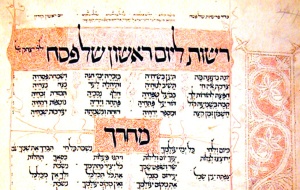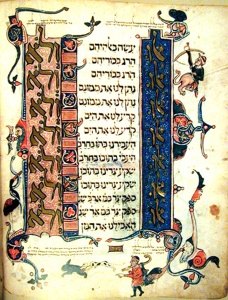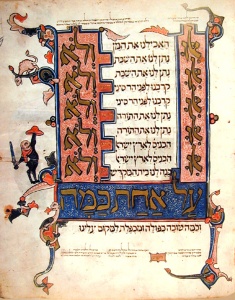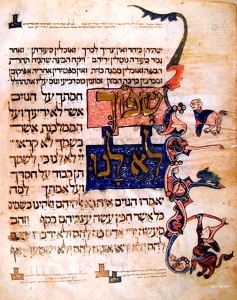The Rylands Haggadah: A Cry from Catalonia, Part II
In the late 1300s a masterpiece of Jewish Art was produced in Northeastern Spain in Catalonia. Over the years this Jewish community had been subject to increasing hostility from their Christian rulers in the form of repressive decrees, forced sermons and conversions. In 1391 lawless mobs attacked and massacred Jews in Barcelona and many other Spanish cities. The Rylands Haggadah (the original is currently at the John Rylands University Library of Manchester, England and a facsimile was published in 1988) represents a unique insight into the tumultuous Medieval Jewish world of Catalonia and Provence.
The Rylands Haggadah opens with a section of piyutim followed by a poetic setting of halachic material to be read on Shabbos haGadol. These halachic pages are beautifully illuminated with ornate painted word panels in delicate pinks and lavenders, surrounded by blocks of micrography. Micrography is miniature writing done in the form of figural shapes and decorations that create images with the text itself. This miniature text begins a digest of the Gemara by the Rif on Pesachim. On one side we see a motif of peacocks in the midst of foliage against a geometric background contrasting with the opposite page of interlacing geometric motifs. Dr. Leila Avrin (former lecturer Hebrew University, author of Micrography as Art) has commented that the existence of this micrography is unique among Sephardi Haggadot.
This uniquely beautiful micrography also graces the piyutim found after the main Haggadah text. Alternating pink and lavender word panels decorate the concluding 30 pages of soft and delicate illuminated piyutim composed for the prayer services of the first and last days of Yom Tov and for Shabbos Yom Tov. The text of the piyutim is flanked by numerous blocks of fantastic micrography continuing the Rif’s digest of Pesachim. This text in micrography creates images of geometrical and floral motifs, a chase scene containing a dog, a stag, another dog and a rabbit and; finally, a fantastic procession of a fox, a bird, a dog and a stag. If this micrography was all the Rylands Haggadah offered we would have an object that represented years of delicate and painstaking labor and devotion. But it is only the beginning of this masterpiece.

Following the initial piyutim and micrography there are thirteen pages of painted miniatures (two paintings per page) that chronicle the Exodus; from Moses at the Burning Bush to Yezias Mitzraim. These wonderful paintings represent a shift from the opening poetic evocations of Pesach and its laws to vivid visual depictions of the narrative itself which we will be soon relating to awaiting family and friends at the Seder table. Then the Haggadah proceeds with the Yom Tov Kiddush and Ha Lachma Onyah. Both the miniature paintings and this beginning section were discussed in last week’s column.
The Rylands Haggadah now presents us with 30 pages of beautiful and intensely illuminated text. Each page is punctuated with from one to three glowingly decorated word panels. The leading word of each paragraph is writ large in gold leaf letters within its own colored and decorated panel. The backgrounds of the panels are either pink or rich blue overlaid with a delicate white tracery floral pattern. Many of the panels extend its fantastic design up and down the adjacent margins with bold and inventive forms in red, blue, pink and white. Animals, figures and grotesques emerge and morph into one another in a riot of invention and droll humor typical of medieval manuscripts.
Rabi Elazar, the Chacham, Rabi Yosi, Rabi Eleazar, Rabi Akeiba, and Raban Gamliel are depicted studying their respective texts seated on thrones or on marble benches along side their specific word panels. Since this is the only place in the text of the Haggadah that human figuration is depicted (aside from the fantastic decorative figures and animals) their depiction gives these masters a prominent place in the entire scheme of the Haggadah. Our rabbis are always central to our Haggadah experience, as is evidenced by a running commentary on the main text, top and bottom, in micrographic lettering by an as yet unidentified author.

The passage of Daiainu is elaborately decorated and framed in what may be one of the pictorial summits of the Rylands Haggadah. The passage starts with Ka’ma ma’alos, (How many abundant favors…) written in gold leaf and the words, ei’lu and ve’lo continue in gold leaf in each refrain. This stupendous two page sequence concludes with Al achas ka’ma (How much more…).

The entire passage is framed in deep blue and pink borders that are alive with fantastic animal and figurative decoration. The sumptuous decoration raises the sense of gratitude to a fever pitch. One sees the depth of emotion that the Catalonian Jews must have felt as they praise the Ribbono shel Olam for having brought us out of the Egyptian bondage to be able to sit at the Seder table tonight, in spite of the troubles and persecutions that hung over them.
Perhaps the only other place where the emotions of the Catalonian Jews break through as clearly is after the benching in the concluding section.

“Pour out (Your wrath upon the nations that do not recognize You)” startles us with it stately gold letters as it is connected with the equally emphatic “Not for us…” also in gold letters but on a contrasting blue background. The terse anger of the fantastic creature in the margin expresses forcefully the cry of the Catalonian Jews for righteous justice from their Maker.
Soon as free men and women we will recount how God took us out of the land of Egypt so that He could be our God and we could be His people. This masterpiece of fourteenth century Jewish Art, the Rylands Haggadah, helps us to fully understand how our Festival of Matzot is indeed a precious time of our Freedom.
The Rylands Haggadah A Medieval Sephardi Masterpiece in Facsimile, The John Rylands University Library of Manchester, England Harry N. Abrams, Inc. New York, 1988